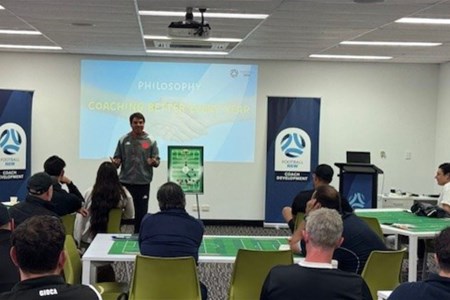Moore Park unearth new artificial sports field


A new all-weather community sports field that will attract 40,000 people a year has been officially opened in Centennial Parklands, and has been welcomed as an important step in addressing a shortage crisis of inner-city playing space.
The field, located in Moore Park, has been created with flexibility and scalability in mind, something that will benefit the Eastern Suburbs Football Association.
Designed to meet FIFA standards, it also has single field full-size capacity, or can be quickly partitioned off as five small sided pitches for junior or mini-sports.
“The Moore Park synthetic field is a fantastic initiative by Centennial Parklands, and a huge win for community sport and the thousands of footballers in the inner city who struggle to find places to play,” said Football NSW’s Head of Communications, Facilities & Government Relations Ricardo Piccioni.
“Hopefully this development will inspire a number of metropolitan Local Councils to invest in synthetic football fields to help meet the huge demand from our participants.”
“Centennial Parklands is the largest community sports precinct in Australia, in terms of number of registered users and number of facilities we maintain,” said Ed Sanderson, Director Sport and Recreation at Botanic Gardens and Centennial Parklands.
“The two key challenges we face when it comes to our community sports fields is demand and wet weather. While we have 35 turf sports fields across the Parklands, we still cannot satisfy demand. There are around 650,000 registered sports users that use the Parklands facilities and fields every year, and this is growing substantially.”
“Through improved management and maintenance, we have been able to increase utilisation of our fields by around 15 per cent, year-on-year, but even this struggles to match the growth in demand.”
While these are positive signs for the health and fitness of our community, the Parklands – like many other public landowners – is looking at more innovative ways of hosting greater numbers of users on limited lands.
“By the end of this financial year we will have around 3,500 additional sporting hours capacity available for the public to use as a result of this field. The ability to do more with the same space is critical, and to this end we estimate that one all-weather field can take the carrying capacity of three traditional turf fields.”
“Innovation is the key – and we take that a step further with this field. We have also built in the ability for the field to capture and direct surface water to nearby Kensington Pond, which will then be used for irrigation of other fields around Centennial Parklands. It is all part of our sustainable future here in the Parklands.”


